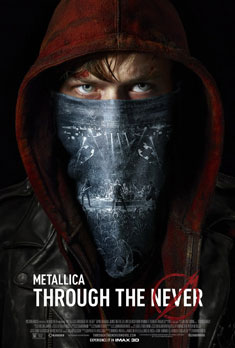Metallica: Through the Never isn’t a ‘concert’ film. There’s a narrative running through the 90 minute running time involving a roadie (played by Dane DeHaan) who’s sent on an urgent mission, but the 3D film does include Metallica’s most iconic songs so fans will have plenty to listen to throughout the movie. And in support of its upcoming theatrical release (in IMAX on Sept. 27, conventional theaters on October 4), band members Kirk Hammett and Robert Trujillo talked about collaborating on the film and shooting the concert footage.
Kirk Hammett and Robert Trujillo Metallica: Through the Never Interview:
Where did the idea for this massive film project come from?
Kirk Hammett: “It wasn’t really our idea, it’s our manager’s idea to put together a stage show so massive that you’d have no choice but to document it in 3D and IMAX. He didn’t sell it to us like that but, basically, it was our manager’s idea to come up with a huge stage, play all our greatest hits, film it, and put it out to the masses. The idea was to always to do in 3D IMAX. We actually tried to an IMAX film about 10 years ago but it didn’t pan out, and so this idea was kind of riding on the heels of that old idea of making an IMAX movie. He just convinced us to build this massive stage, which is the other star of the movie is the stage. The stage is so huge, I mean, it’s a spectacle in itself.”
Robert Trujillo: “It’s the biggest indoor stage, but the interesting thing is is the stage, they had already started production of the stage. We didn’t even really know how far along and how this thing was progressing, and we had a meeting in, was it Ireland or somewhere?”
Kirk Hammett: “Yes, somewhere.”
Robert Trujillo: “They’re already building a stage. The money’s already been spent, so our manager…”
Kirk Hammett: “I mean, we hadn’t even confirmed.”
Robert Trujillo: “We haven’t even confirmed it. They were so excited about presenting this, so the guy who built the wall, he designed the stage, so we have this meeting, and then in one hand, it was really exciting because, ‘Wow, this is an incredible stage.’ But on the other hand it was kind of, ‘How much did this thing cost?’ Then, there was also like we wanted to have a narrative with the concert film and not just have it be another Metallica concert being filmed. That’s where kind of things got a little bit … we were head-butting a little bit because they had intended it to be just a full-blown concert film. And then we as a band were like going, ‘Well, let’s do something different – a narrative.’ That’s when this kind of happened.”
Kirk Hammett: “Whose initial idea was the narrative? I can’t even remember.”
Robert Trujillo: “The narrative kind of came up together at the meeting with Lars, James and I.”
What’s different about this stage? Does it have to be specialized, especially in this 3D environment?
Kirk Hammett: “We had this old concept … well, it’s old to us … but it’s the snake pit, and what it is is a special stage built so that we can bring people in this little area that’s in the front of the stage and make them a part of the show. This stage has two snake pits, one on each end, and that’s just the beginning. The whole surface of the stage are video monitors and so you can project multiple images or one gigantic image on this stage. The stage is what, like 80 feet long or something crazy like that? 100 feet long or something. It’s about a third longer than our usual stage, so we have to work about a third more. [There’s a] lot more running, and we have to be in shape. There’s all these things built into the stage.”
Robert Trujillo: “There’s a lot of pyro.”
Kirk Hammett: “Yes, pyro stuff, stuff rises out of the stage.”
Robert Trujillo: “You’ve really got to know the lay of the land.”
Kirk Hammett: “Yes. It’s very interactive, and there’s a lot of moving parts and a lot of exploding parts.”
Robert Trujillo: “The other thing too was, which is really interesting, is our management had us basically do live performances in Mexico City. So we had eight shows, 20,000 people a night, with this stage to work it out, to get our cues down, and also help with the lighting. And then we had two production shows, so there was 10 shows in Mexico City. We were there for two weeks in front of the most insane audience you could ever imagine, so by the time we went to Vancouver to film this thing, we had it down. But it’s like getting thrown into the trenches, and it’s like between the elevation factor in Mexico and the wild audience and everything, we were really well-prepared. We had our cues down. We knew where it was safe, and we were on fire in terms of being tight and ready to film this thing.”
How much input did you have into developing the narrative?
Kirk Hammett: “I think we all did. I mean, when we decided to add the narrative, we put the call out there to a bunch of directors to see what ideas they had, and about four or five really great ones came through. I would say, I don’t know the exact numbers, but four of them were science fiction they used and one of them was Nimrod’s, and Nimrod’s just stood out. That’s something that was doable, something that was more in line with the feel of the band, and his plot line was malleable for us to shape and form in whatever ways we needed to shape it.
I mean, all four of us with Nim worked on shaping the script. We did a lot of changes and had a lot of input and suggestions, and he was really open and accepting. We just saw some of the final cuts of the movie this week and it’s really taking shape. Now it’s very, very cohesive and we’ve managed to steer it into the direction which is more a sort of direction that has more of a Metallica feel. As a monster kid, of course, I have a million ideas because the narrative does have its elements of horror. It has its dark moments. We all had a lot to say. We had a lot of input.”
Robert Trujillo: “That’s what was so exciting about it was connecting with a director that was open to suggestion and would listen to your ideas and, in some cases, actually use them. A lot of guys that came in already had treatments that they put together in the past, and they were just trying to kind of pawn it off on us to use them. Whereas Nimrod customized something for the situation, which is basically, you already have a stage that’s built. You already has a set of music that’s been chosen. Now direct this and write it.”
Was there anything you had to adjust to working with the 3D cameras?
Kirk Hammett: “We’re used to filming concerts for videos, live concert footage. Having cameras onstage isn’t anything new to us. The fact that we’re filming in 3D though, it kind of like changed my perspective because when you’re conscious of filming a 3D movie, you know that stuff that has forward momentum that’s coming toward the camera is the most effective in 3D. So I think there was a lot more playing to the camera and kind of customizing our moves, or actions, so that it would accommodate 3D action or whatever. I found myself just playing to the cameras a little bit more than usual because it’s 3D, it’s IMAX, and you know, it’s what you’re there for.”
Robert Trujillo: “There were a couple of reckless moments in Oakland. We’re rehearsing and there was actually a fire. One of the curtains above, you know, trial and error, and the thing caught on fire. Luckily, they were able to get somebody up there to put it out. In another situation, one of the cable cams came flying down in Vancouver.”
Kirk Hammett: “It was on a zip line.”
Robert Trujillo: “A zip line, and it literally missed my head like this, and then it came down, and it was stopped by the barricades and went, ‘Bam!’ Luckily, there wasn’t a security guy standing in front of the barricade and there were fans on the other side, so they were protected by the barricade.”







